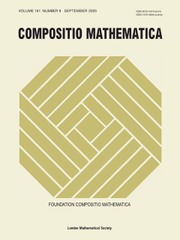No CrossRef data available.
Article contents
Common graphs with arbitrary chromatic number
Published online by Cambridge University Press: 03 July 2025
Abstract
Ramsey’s theorem guarantees for every graph H that any 2-edge-coloring of a sufficiently large complete graph contains a monochromatic copy of H. In 1962, Erdős conjectured that the random 2-edge-coloring minimizes the number of monochromatic copies of  $K_k$, and the conjecture was extended by Burr and Rosta to all graphs. In the late 1980s, the conjectures were disproved by Thomason and Sidorenko, respectively. A classification of graphs whose number of monochromatic copies is minimized by the random 2-edge-coloring, which are referred to as common graphs, remains a challenging open problem. If Sidorenko’s conjecture, one of the most significant open problems in extremal graph theory, is true, then every 2-chromatic graph is common and, in fact, no 2-chromatic common graph unsettled for Sidorenko’s conjecture is known. While examples of 3-chromatic common graphs were known for a long time, the existence of a 4-chromatic common graph was open until 2012, and no common graph with a larger chromatic number is known.
$K_k$, and the conjecture was extended by Burr and Rosta to all graphs. In the late 1980s, the conjectures were disproved by Thomason and Sidorenko, respectively. A classification of graphs whose number of monochromatic copies is minimized by the random 2-edge-coloring, which are referred to as common graphs, remains a challenging open problem. If Sidorenko’s conjecture, one of the most significant open problems in extremal graph theory, is true, then every 2-chromatic graph is common and, in fact, no 2-chromatic common graph unsettled for Sidorenko’s conjecture is known. While examples of 3-chromatic common graphs were known for a long time, the existence of a 4-chromatic common graph was open until 2012, and no common graph with a larger chromatic number is known.
We construct connected k-chromatic common graphs for every k. This answers a question posed by Hatami et al. [Non-three-colourable common graphs exist, Combin. Probab. Comput. 21 (2012), 734–742], and a problem listed by Conlon et al. [Recent developments in graph Ramsey theory, in Surveys in combinatorics 2015, London Mathematical Society Lecture Note Series, vol. 424 (Cambridge University Press, Cambridge, 2015), 49–118, Problem 2.28]. This also answers in a stronger form the question raised by Jagger et al. [Multiplicities of subgraphs, Combinatorica 16 (1996), 123–131] whether there exists a common graph with chromatic number at least four.
MSC classification
Information
- Type
- Research Article
- Information
- Copyright
- © The Author(s), 2025. The publishing rights in this article are licensed to Foundation Compositio Mathematica under an exclusive licence.


